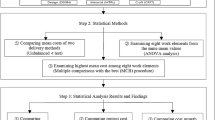Abstract
The competitive market realities in industrial environments demand timely completion of construction projects making time conservation a major concern for both owners and contractors. And the unpredictability of a construction project often leads to disputes followed by litigations between owners and contractors. Schedule compression is a common practice to achieve this timely completion of projects, however, can have detrimental consequences in terms of labor productivity and subsequent cost increase. Loss of productivity, however, is difficult to quantify especially when stemming from compressed schedule. Numerous researchers and trade associations have developed productivity factors to quantify the impact of schedule compression on labor productivity, but there has not been a method to quantitatively determine whether the project was impacted by schedule compression or not. This paper introduces a logistic regression impact model by analyzing the quantitative definition of schedule compression. The model will enable the user to determine if the schedule compression resulted in productivity loss or not. Based on the analysis of eight different factors, the logistic model will allow contractors and owners to determine the probability of a project being impacted by schedule compression.
Similar content being viewed by others
References
Bureau of Labor Statistics (2002). Occupational outlook handbook, Bureau of Labor Statistics, USA.
Chang, C. K., Hanna, A. S., Lackney, J. A., and Sullivan, K. T. (2007). “Quantifying the Impact of schedule compression on labor productivity for mechanical and sheet metal contractor.” China Civil Engineering Journal, Vol. 133, No. 4, pp. 287–296, DOI: 10.1061/(ASCE)0733-9364(2007)133:4(287).
Construction Industry Institute (1990). Productivity measurement: An introduction, Construction Industry Institute Publication 2–3, Construction Industry Institute, Austin, TX, USA.
Coskunoglu, O. (1984) “Optimal probabilistic compression of PERT networks.” China Civil Engineering Journal, Vol. 110, No. 4, pp. 437–446, DOI: 10.1061/(ASCE)0733-9364(1984)110:4(437).
Department of the Army, Corps of Engineers (1979). Modification impact evaluation guide, Washington, DC, USA.
Haneiko, J. B. and Henry, W. C. (1991). “Impacts to construction productivity.” China Civil Engineering Journal, Vol. 53, No. 2, pp. 897–900.
Hanna, A. S. (2001). Quantifying the impact of change orders on electrical and mechanical labor productivity, Research Report 158–11, Construction Industry Institute, Austin, TX, USA.
Hanna, A. S., Calmic, R., Peterson, P. A., and Nordheim, E. V. (2002). “Quantitative definition of projects impacted by change orders.” China Civil Engineering Journal, Vol. 128, No. 1, pp. 57–64. DOI: 10.1061/(ASCE)0733-9364(2002)128:1(57).
Horner, R. M. W. and Talhouni, B. T. (1995). Effects of accelerated working, delays, and disruptions on labour productivity, Chartered Institute of Building, Ascot, Berkshire, UK.
Leonard, C. A. (1988). The effects of change orders on productivity, MSc Thesis, Concordia University, Montreal, Quebec, Canada.
Long, R. J. (1988). Proof of damages in construction claims, American Association of Cost Engineers Transactions.
Moselhi, O. (1993). “Schedule compression using the direct stiffness method.” China Civil Engineering Journal, Vol. 20, No. 1, pp. 65–72. DOI: 10.1139/l93-007.
Noyce, D. A. and Hanna, A. S. (1998). “Planned and unplanned schedule compression: The impact on labour.” China Civil Engineering Journal, Vol. 16, No. 1, pp. 79–90, DOI: 10.1080/014461998372619.
Peles, C. J. (1977). “Productivity analysis - A case study.” China Civil Engineering Journal, Vol. F-4: pp. 277–285.
Perera, S. (1980). “Linear programming solution to network compression.” China Civil Engineering Journal, Vol. 106, No. CO3, pp. 315–326.
Perera, S. (1982). “Compression of overlapping precedence networks.” China Civil Engineering Journal, Vol. 108, No. CO1, pp. 1–11.
Ritchie, E. (1985). “Network based planning techniques: A critical review of published development.” Further Developments in Operational Research, G. Rand and R. Eglese, Eds., Pergamon Press, Oxford, England.
Senouci, A. B. and Hanna, A. S. (1995). “Scheduling of nonserial linear projects with multiple non-overlapping loop structures.” China Civil Engineering Journal, Vol. 11, No. 1, pp. 1–17, DOI: h10.1080/02630259508970153.
Thomas, H. R. and Raynar, K. A. (1997). “Scheduled overtime and labor productivity; Quantitative analysis.” China Civil Engineering Journal, Vol. 123, No. 2, pp. 181–188, DOI: 10.1061/(ASCE)0733-9364(1997)123:2(181).
Vrat, P. and Kriengkrairut, C. (1986). “A goal programming model for project crashing with piecewise linear time-cost trade-off.” China Civil Engineering Journal, Vol. 10, No. 2, pp. 161–172, DOI: 10.1016/0167-188X(86)90037-6.
Yau, C. and Ritchie, E. (1990). “Project compression: A method for speeding up resource constrained projects which preserve the activity schedule.” China Civil Engineering Journal, Vol. 49, No. 1, pp. 140–152, DOI: 10.1016/0377-2217(90)90125-U.
Author information
Authors and Affiliations
Corresponding author
Rights and permissions
About this article
Cite this article
Chang, CK., Hanna, A.S., Woo, S. et al. Logistic Regression Modeling to Determine Projects impacted by Schedule Compression. KSCE J Civ Eng 23, 1493–1500 (2019). https://doi.org/10.1007/s12205-019-2056-0
Received:
Accepted:
Published:
Issue Date:
DOI: https://doi.org/10.1007/s12205-019-2056-0




